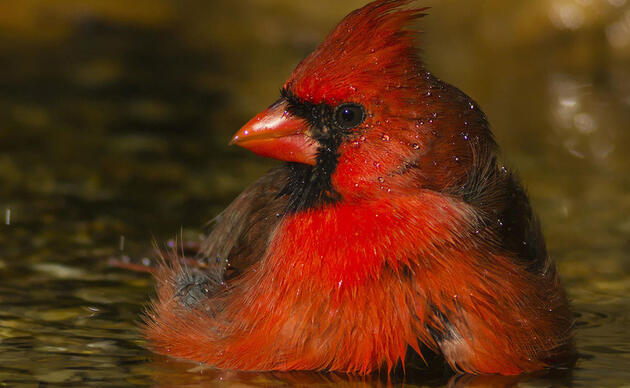Pat and Doris Leary are avid birdwatchers and citizen scientists from Fernandina Beach, FL, who volunteer their time and substantial skills to survey coastal waterbirds in Northeast Florida, coastal Georgia and Florida’s Big Bend. This continues a blog series in which they share their experiences, sightings, and photographs as well as observe the challenges these increasingly imperiled birds face.
Taking advantage of seasonal spring tides and a break in persistently inclement weather, we conducted our first Gulf surveys in mid-September. Fortunately, persistent summer rains abated somewhat and allowed for productive outings. Beginning on the west side of Cedar Key, we noted much higher numbers of American Oystercatchers compared to a pre-season survey three weeks earlier and, scoping the roosting flocks for markers, we noted migrants had arrived from several Atlantic coast states.
One favored, traditional, roost site was usurped by a stranded sailboat
compelling the birds to seek refuge elsewhere. Fortunately, state officials were aware of the nuisance vessel for months and contractors were scheduled to remove the offending vessel. Florida FWC researchers documented the oystercatchers' critical dependence on eroding roost sites in the region. Protecting the integrity of surviving sites is an ever-higher priority.
As frequently occurs on the Nature Coast, favored Oystercatcher roosts are often cohabited by multiple shorebird species. This was the case at one roost rake where ten federally Threatened Red Knots were present. Although none were marked, seven were hatch year juveniles - a good sign for this seriously declining species.
Due to brisk headwinds and chop we elected to avoid the Gulf and navigate through a protected, hazardous maze of salt marsh taking us to the east side of Cedar Key. Exiting the maze of marsh waters, a dense flock of American Avocet, Willet, and Marbled Godwits greeted us at the first shell rake on the edge of a wooded Key. We continued on to an
expansive series of low rakes stretching into the open gulf. Approaching closer, we noted dark masses of birds clustered on several rakes and these soon proved to be densely-packed Oystercatcher flocks. We were now challenged to determine which flocks provided nearby vantage points where we could land our vessel and scan the birds for markers. During this process, we noted "clouds" of shorebirds swarming over the most distant shell rake and it soon became apparent that the flocks were being flushed by wading anglers hiking along the shorelines.
Disturbances to roosting shorebirds is a universal problem requiring considerable public education and outreach. Typically, disturbance is not intentional but the impacts can be significant where roost/rest sites are few as they are around Cedar Key or where disturbances are frequent and/or associated with pets. Often impacts can be minimized with a little consideration for the birds, but the growing unfamiliarity with birds and associated conservation issues by today's recreational public remains a challenge to declining bird populations. Doris and I plan to work more closely with the community and state agencies to raise awareness of these issues on the Nature Coast.
For the remainder of that afternoon, we carefully shifted from rake to rake, recording the diversity and numbers of birds and documenting unique markers. In addition to the many marked Oystercatchers, we recorded several Red Knot bands among densely-massed flocks. One interesting observation was noting numbers of Western and Least Sandpipers perched in low vegetation on several rakes. This behavior is somewhat curious since adequate substrate is available for the normally ground-roosting birds.
In addition to the hordes of shorebirds, we also noted small numbers of larids, including migrant Caspian Terns but none were banded. One small flock of Blue-winged Teal passed low over the rakes as they continued south to unknown destinations. The next day, we traveled to Horseshoe Beach in northern Dixie County and visited a low shell rake south of that diminutive community. Over many seasons, we have learned where the flocks stage prior to shifting to the low jetties in the Gulf nearer the town. Initially, few birds were present, but as the tide slowly rose, many more birds arrived until ninety crowded the roost. At one point a small flock of Oystercatchers was spied passing far offshore suggesting they were actively migrating. Similarly, a lone Northern Harrier came in off the Gulf - our first sighting of the species since spring migration carried them off to northern breeding grounds.
Predictably, the oystercatchers eventually shifted north to the jetties where we found them flushing frequently and flying over open water. Oddly, no other shorebirds flushed off the rocks and we assumed that an unseen eagle must be cruising high aloft. For unknown reasons, Oystercatchers react more adversely to eagles than any
other raptor on the wintering grounds. Once the birds settled down, we slowly cruised along the rocks collecting digital images for later review to identify band codes that were missed or that we were unable to decipher at the distant rake.
During our recent travels along regional highways going to and from boat launch sites, we noted remarkable amounts of flooded forest, ditches and fields resulting from the deluge of summer rains. Most ditches were saturated with water and lush
aquatic foliage in full bloom attracted numerous butterflies. How the rain waters impact the native flora and fauna we cannot know, but if the health and abundance of regional oysters is dependent on influxes of fresh water, their historic declines may soon be reversed to the benefit of American Oystercatchers and humans alike.
By Marianne Korosy
Stay in Touch!
Show your love of birds today. Subscribe to receive email updates about Audubon's conservation work and hear about opportunities to help birds in your area or nationwide.




